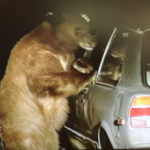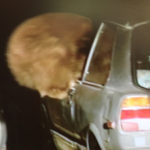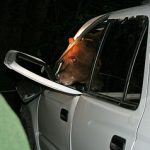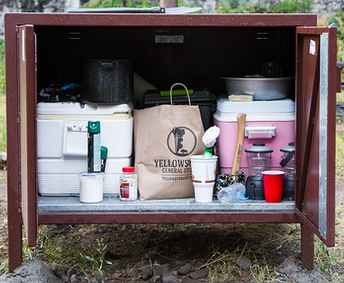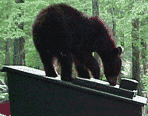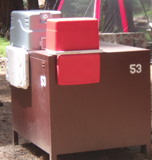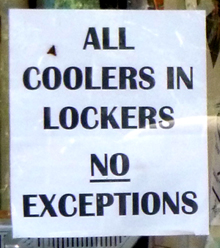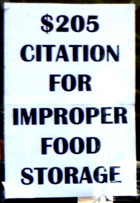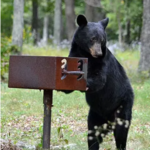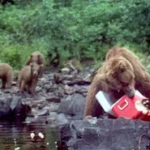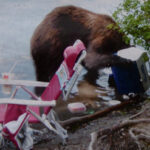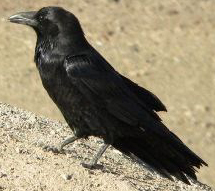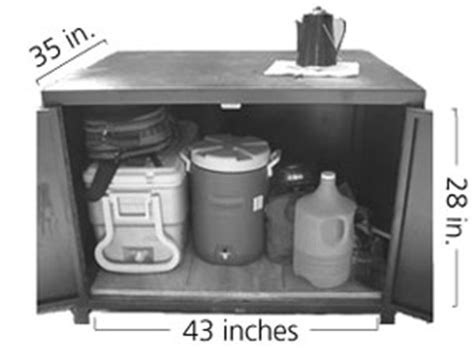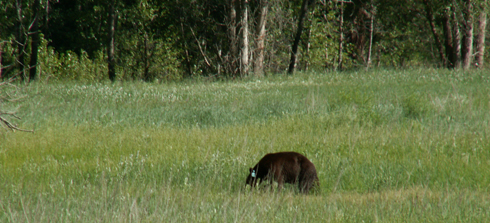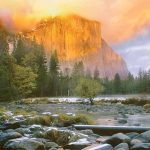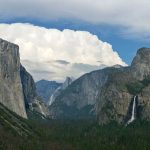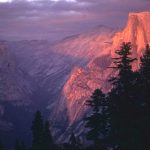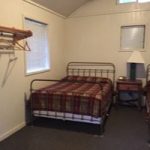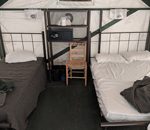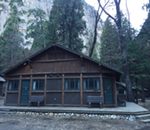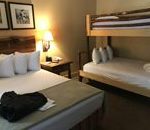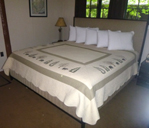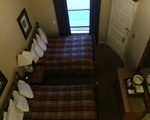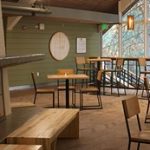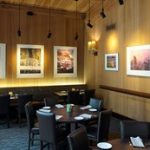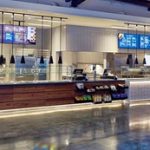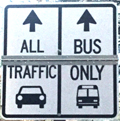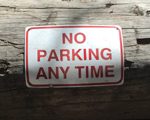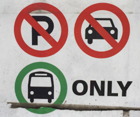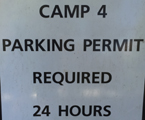Each campsite and canvas tent cabin in Yosemite and Grand Teton National Park, (as well as some trailheads, parking lots and overnight accommodations), has a metal food storage locker (bear box). Many other parks also have these “bear boxes,” where they are sometimes called “bear bins.”


See also: using a bear resistant food storage container for the backpack sized, portable models.
This page gives you ideas on how to use one, including some logistics on sharing one in a large group and how to try to fit everything into a bear locker.
Sizes of the bear-raccoon-coyote proof (if used properly) Yosemite food lockers are near the end of this webpage.
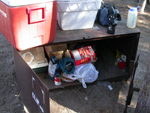
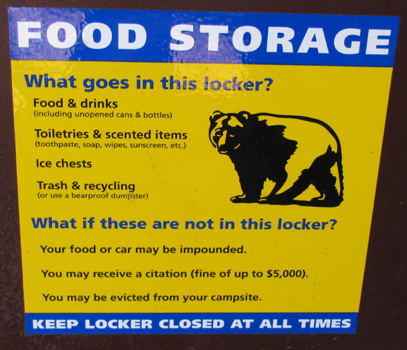

KEEP DOORS CLOSED means keep them fully closed and latched.
– – – – – – – – – – – – – – – – – – – – – – – – – – – – – – – – – – – – – – – – – –
Yosemite warns: “Improper food storage may result in impoundment of your food or car, a fine of up to $5,000, and/or revocation of your camping permit.”
“While camping in Grand Teton National Park, a woman failed to properly store garbage and beverages resulting in a grizzly bear receiving a food reward when it found the unattended garbage and drink at the campsite. . . . The campground contained multiple warning signs about bears and proper food storage as well as bear boxes in which food and other items could be stored. “
United States Attorney’s office, District of Wyoming fined the woman $5,826.99 in restitution for improper food storage, a misdemeanor offense. It included the fine and payment for costs for the operation to relocate the bear, “including the cost of a GPS collar now necessary to track the bear’s movement.”
– – – – – – – – – – – – – – – – – – – – – – – – – – – – – – – – – – – – – – – – – –
Bears break into vehicles (including car trunks), tent-trailers or tents to get at food or even containers shaped like food seen through the windows, so campers need to put all food, ice chests, toiletries, stoves with spilled food, water bottles that had lemonade mixed in them, trash that didn’t quite get to the bear-proof dumpster, pans and dishes in the bear box.
To see bears breaking into cars and get the most current advice, watch the video the photos above are from at:
https://www.nps.gov/yose/planyourvisit/fdvideo.htm
Bears (and raccoons) are incredibly quiet when walking and can sneak up and get food off a picnic table that people were sitting at.
Black bears are strong enough to bend open an improperly latched bear box door.
A bear may enter your campsite day or night, even in the presence of many people, dog(s) even large ones, a big campfire or lots of lights, even motion sensor lights. Running your vehicle engine or generator, playing loud music, motion-activated sound systems simulating a barking dog, trying various ‘repellents’ (mothballs, an open bleach container, pine-scented cleaner, fabric softener sheets or ammonia soaked rags hanging everywhere, dog or cat in-the-garden repellent, etc.) will not work.
A ranger wrote: “I talked to some campers who were completely freaked out about bears, so much so that they turned their generator on (after quiet hours) in hopes that it would deter a bear. Meanwhile, they had all their food out all over their campsite.”
Clean out your car . . . before the trip
You can’t trust your own nose; look around the car, including under the seats for that one old, stale french fry, and in the glove compartment, thoroughly. Take the gum wrappers out of the ashtray. Hey, no heavily scented air fresheners hanging from the rear-view mirror!
If the child seat has food spilled on it, scrub it before the trip. Some parks recommend leaving it sitting outside of the car and/or tent overnight or when away from the campsite and not actually using it, so plan ahead for a rain-proof cover.
No bottle of brake fluid or spray can of deicer showing, the bears don’t know it’s not food and will break into your car because they see an item the shape of a food container. A daypack or backpack also looks like a food container to a bear.
Remove night crawlers or salmon eggs from the fishing gear.
Bears have an powerful sense of smell. For example, they can smell a banana in an ice chest in the closed trunk of a vehicle. To get at that banana, a bear broke into a door window and clawed through the backseat.
And when you arrive at your campsite, cabin, hotel room, keep these in mind:
Air out your vehicle if you eat burgers or pizza on the way to the park and clean up any crumbs.
When you arrive and as you unpack the open truck bed, leave someone with the gear. Don’t leave a car door open while you go back and forth unpacking.
Get the food/toiletries out of your vehicle right away when you arrive at the campsite/ tent cabin / hotel room. In 2005 Yosemite started warning: “Bears break into cars during the day time. So even while on a day hike, store all scented items in lockers.”
The mini-lock on the tent zipper is useless, animals will just tear the tent fabric. Raccoons can unzip tent zippers.
Don’t put valuables (wallet, car keys, fanny pack, day pack) in a bear box. And if you leave them in your car they should not be showing. Likewise, valuables left on a shelf, table, desk in a hotel room /cabin / cottage that show thru a window are an invitation to a thief.
Bears and raccoons can climb up to hotel room balconies so no, you can’t store your ice chest / cooler on the balcony. Raccoons have torn screens off windows to get into hotel rooms and cabins when people leave your window open when they are not in the room.
Bears are not true hibernators, so they wake up occasionally and break in to cars and take food off picnic tables in the winter.
Playing a bean bag toss game? Yup, a bear ate the beans from bean bags from a game people left out, so either think of a different game to play or put the bean bags in the food locker.
That pumpkin you carved for Halloween is also food.
The carrot stick you want to use for a nose on a snowman is also food, so use a stick instead.
———————–
Typical mistakes people make with bear boxes include:
Overstuffing the box and not being able to really shut it tight. On some models a bear might not get the door open, but a raccoon can reach in through the crack, snag food bags with his paws and make a mess all over the campsite overnight.
Assuming that because people are in the site the doors don’t have to be latched all the time is a big mistake. Bears (and lots of raccoons) enter campsites during meals to try to get food off picnic tables, from vehicles with doors open or from bear boxes that weren’t latched.
Don’t turn your back on food, keep it within arm’s reach.
Don’t leave bear box door open beyond the time it takes to get out what you need.
Don’t open it and turn away to carry food to the picnic table, without shutting and locking it.
Don’t leave items sitting on top of the bear box unless you are standing right there eating them.
From a Yosemite Daily Report of June, 2004:
“Bears are getting food from visitors that are too far from their food.
(Farther than arms length is too far and any food behind the back is an invitation.) “
If you are only making and eating a sandwich, for example, you can do the food prep on top of the food locker, shut and latch it and sit down to eat.
But if you are cooking food, especially with multiple courses, you need at least one partner. The two of you look in the storage locker for what you will need. Then perhaps you move out the ice chest/cooler (and shut/latch the door behind you as you move it to the picnic table). One of you can sit at the picnic table with what is being brought out, starting food prep, while the other goes back to get more things. (It could be wise to take a bathroom break just before you start making a meal, since one of you will need to stay with everything (and that campfire you started as well) if the other leaves the campsite.)
No, you r-e-a-l-l-y should not leave the door open as you go back and forth from the food locker to the picnic table, even if you are sure you do not see any animals in the vicinity. Raccoons can be especially fast getting in and out of food storage lockers. You might hear “hey get out of there” from your neighbors just before you hear them banging the food locker door shut. See: camping blunders for more stories.
This National Park Service photo shows people sitting at their campfire with their backs turned to food behind them out on the picnic table. It would be easy for a bear, raccoon, bird or other critter to sneak up to the table and get a food reward and
they could be subject to a citation and pay a BIG fine:
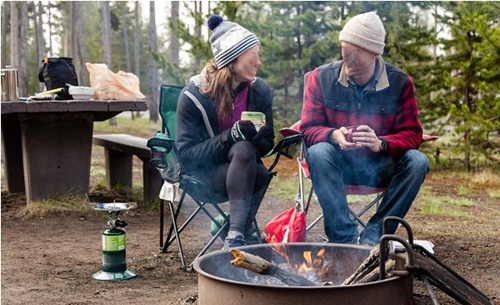
————-
When camping with a large group of people we have found that some
complain there is not enough room in their shared bear box for all their gear.
In the summer at Tuolumne, when we often get a group campsite, we have had serious problems fitting everything. For many years on our winter Yosemite valley trip the Rangers let us use bearboxes in closed campsites in the rest of the campground, but in 2004 a Ranger said we would need to buy more campsites instead and that has been the policy ever since. And no, it would not be a great idea to just sneak your excess food into a bearbox in a vacant winter loop, if they get more campers and open up more loops, you could lose your food, ice chest, etc.


The size of the bear box (most are 35 inches deep by 43 inches wide by 28 inches tall, but you might still find some 33″ deep x 45″ wide x 18″ tall), lets you plan what you can bring.
The front opening sometimes has a flange around the inside of the opening. The inside is actually a little bigger.
Measure your ice chest(s) in advance. Models of “xtreme” coolers can be 33.5 x 17.9 x X 17.5 inches OR 28.1 x 15.5 x 18.13 inches and there would be very little space left in the bear box for the pans / dry food / toiletries, so you would need to plan carefully. Some mega-quart capacity coolers, especially with wheels, are quite tall and won’t fit in.
Plan in advance to use the space available more effectively.
This page pictures the smaller boxes, the newer, larger Yosemite ones are slightly less wide, but slightly deeper and ten inches taller. Picture a 33 inch by 45 inch space. Then imagine two ice chests slid into the back of the bear box.
Along come more people and they place a stove, two pans, five shower kits of various shapes and sizes, two paper grocery bags of canned/boxed food, a six-pack of soda, a small toiletries duffel bag, a tea kettle, a dish pan with a few things in it and a small shallow box of miscellaneous cooking gear in front of the ice chests.
When the people who put in the ice chests need something from them they need to take out all these individual items. When they put them back in they will doubtlessly not put them back in order.
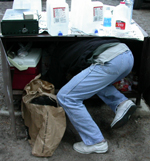
At some point the paper grocery bags will get damp on the bottom from leakage from the ice chests or blown in rain/snow and will disintegrate when they are removed. Cardboard boxes that get wet on the bottom can also disintegrate, even over only one weekend.

More things could fit if everyone brought their gear in shared small, deep plastic trash cans or other plastic boxes close to, but no more than, 17 inches tall. A typical bedroom waste receptacle could be 9″ by 12″ by 17″ tall and hold quite a few cooking items and toiletry bags. Then more gear could fit, since it would not all be spread out in a shallow layer and all of it could be retrieved and replaced more easily.
A big bin, like the blue 23 1/2″ x 16″ by 16 1/2″ tall one pictured below, can hold a large number of single items for multiple people.
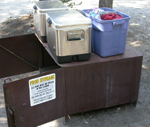
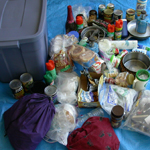
If a big group does not have all the same menu, they should at least plan some ways to have more space by bringing less. If everyone who wants to make sandwiches brings their own 32 ounce jar of mayo and 16 ounce jar of mustard, we will run out of space in the bear boxes. Share condiments or bring small containers.
Likewise, put some cereal in a smaller container instead of each person bringing a full-sized box. Don’t bring a gallon of milk, start with a maximum of a quart and then buy more at the store. You probably don’t need a two pound block of cheddar. Can you bring instant drink mixes and mix as you want them instead of a gallon bottle of punch or lemonade?
If you cook chicken in advance and bone it it will take up a lot less space. (If you bring uncooked chicken you risk the juice leaking into the ice chest and the possible Salmonella contaminating all your food.)
If you break the eggs for scrambled eggs into a tightly lidded jar they take much less space than in the carton they came in from the store. In the photo below, the jar ( at the left of the photo) has eggs, a little grated cheddar, sour cream and chives. It’s ready to be shaken and turned into scrambled eggs or an omelet. And the eggs store more easily in the jar when in an ice chest than in the package they came from the grocer in.
The prewashed and precut raw bell pepper, celery and cauliflower in the lidded plastic container lasted for days and take less space than whole vegies.
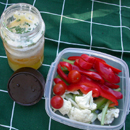
All the food preparation you do in advance
means more time to play on the trip.
If everyone brought a large container of full-sized toiletries, as in the left of the photo below, they would take up too much space. By bringing travel/sample sized containers of shampoo, lotion, etc. in a smaller bag, as in the example on the right in the photo below, there is room for even a full sized can of spray insect repellent.
NO!→ 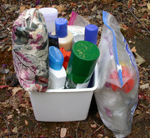 ← Yes!!
← Yes!!
Tear off the appropriate size and number of sheets of foil you will need, fold and pack them with a few plastic sandwich bags as needed instead of bringing whole packages.
Yes! → 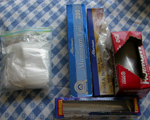 ← No
← No
Antibacterial towelettes are great to clean hands when it’s just not convenient to trudge to the restroom before preparing a meal. But the whole plastic tub will take up too much space in the bear box, bring a few in a zip-lock bag, or a small bottle of liquid.
(And not the lavender or mint scented hand sanitizer that will attract mosquitoes to you and everyone near you.)
Yosemite rules say to dispose of all trash in the dumpster, not to store it in the bear-proof campsite food storage box. And it probably won’t fit in the box anyway. So, make regular trips to the bear-proof dumpster.
Yosemite has recycling bins near many of the restroom dumpsters.
At the end of each campsite loop in Upper Pines campground, for example, there are trash and recycling dumpsters, and at the end of some of the loops, a smaller trash-can-sized receptacle for propane canister recycling only.

Please use the clip on the trash bin to lock it. If a bear gets into a dumpster on a hot day it can be a death trap.
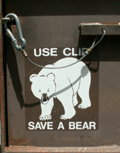
If you notice one is un-clipped, please clip it.
Immediately report it to a hotel front office, ranger or campground host if the clip is missing from the dumpster.
Before clips to hold dumpster lids shut, bears have been trapped in dumpsters. A ranger wrote in his blog: one bear “ended up wandering around the Mariposa County landfill. A few bears have (spectacularly) escaped from trash trucks after being dumped into them. In any case, now dumpsters have clips (but not everyone bothers to use them).”
In the photo above, the note on it says:
“Dumpster Full
This dumpster is full and has been wired shut to prevent black bears from accessing the overflow trash. Please do your part in protecting Yosemite wildlife by finding another dumpster to dispose of your trash. Thank you.”
PLEASE, when a dumpster is full don’t just leave your trash sitting next to it,
find another dumpster.
_______________________________________
As of June 2016 a new rule was added in Yosemite:
“If a park-provided food locker is full, the occupants of that site or unit may store a clean ice chest that is empty, or contains only plain water or ice on top of or next to the full locker.”
In June 2021, the Superintendent’s Compendium put it this way:
“If an NPS-provided food locker is full, the occupants of that site or unit may store a clean ice chest that is empty, or contains only plain water or ice, on top of or next to the full locker.”
BUT reading all signs can be important. You might find a sign, such as this one in the window at the Tuolmumne Meadows campground entrance kiosk:
which is quite different than the Superintendent’s Compendium rule in effect at the time.
Right next to it in the window was this sign:
_______________________________________
(2016 from the website) In Grand Teton you must store all food/toiletries and empty coolers as well as “cookware (clean or dirty), stoves and grills” in the bear box.
_______________________________________
The boxes are dark metal and can build up heat inside, melting your ice faster. If you cover the box with something reflective, like the silver tablecloth yardage below, you can save money on ice.
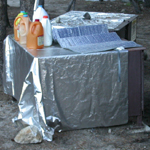
_______________________________________
_______________________________________
ALL MODELS are metal and are noisy when opened or shut. Unless you are careful you can wake up your neighbors who want to sleep earlier or later than you.
_______________________________________
Bears can get into food storage boxes. Not just when people leave the doors open or partially closed for even a short amount of time, but also by trying to get closed doors to open:
“A large untagged/uncollared bear has been seen in Upper Pines and the Wilderness Lot, checking for improperly latched food storage lockers. Visitors have reported this bear going from site to site, banging on the locker latch. Unfortunately, the bear obtained food on at least three occasions from improperly latched lockers.”
_______________________________________
Bears are strong enough to bend car doors open to get into them
and strong enough to pull bear box doors open if they can get their paws into them.
From a park service video played at Yosemite National Park visitor centers, a car door bent open by a bear, and the car owner trying to bend the door back
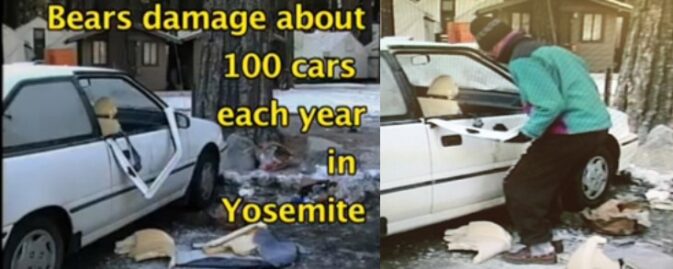
Yosemite bear-proof food locker latching systems has pictures of how to properly latch a bear box.
_______________________________________
Don’t believe anyone who tells you that the bears in Yosemite really don’t break into vehicles. For statistics go to:
Black Bear Management Trends
Park Service photos:
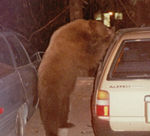
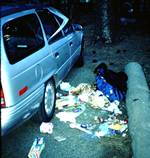
How bears break into cars, what to do if you see a bear and more is at: Bears
A good way to wake up the whole campground is to set your car alarm.
Then if a curious animal or clumsy person bumps the vehicle at night you’ve succeeded.
(a car alarm won’t keep bears out of your vehicle).
Tent walls are thin. You can wake up everybody in the vicinity when you want to get into your car and you use the keyless (remote) door opener and the car makes the usual loud beep. People don’t think to just use the key to open the door or don’t know that if you look in the owner’s manual you can find a way to disable the beep.
For a laugh, go to:
Camping Blunders
also will try to take any food you leave unattended, on your picnic table, hotel patio or balcony table, even knocking the room service metal plate covers off the plate. Staying with your food and keeping food within arm’s reach is a wise idea at every National Park restaurant with outside dining, hotel, cabin, campsite, picnic area or where you stop to eat along a trail. (Ravens are bigger than a Crow you might see at home. Ravens are 24 inches long and have a wingspan of 53 inches, Crows are 17.5 inches long and have a wingspan of 39 inches).
Raven sounds can be heard here and here.
The park service offers this photo of an “unattended campsite has been ravaged by ravens,
a common occurrence when food and kitchen items are left unsecured by campers:”
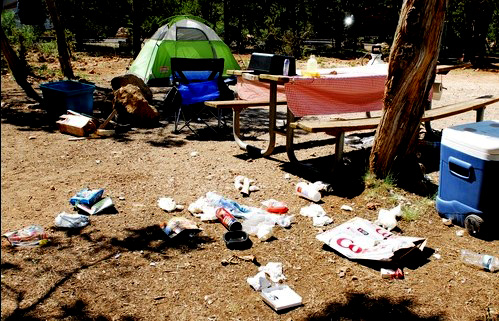
(See also: using a bear resistant food storage container for the backpack sized models.)
Yosemite park offered this at their webpage:
Most Yosemite campsite models measure 35 inches deep by 43 inches wide by 28 inches tall, but you might still find some 33″ deep x 45″ wide x 18″ tall.
The Curry Village website said: “Your cabin comes with one locker measuring:
35.5″W x 20.5″D x 23″ H (Small Tent Cabins)
47.5″W x 20.5″D x 23″ H (Large Tent Cabins)
Guests who don’t comply with our food storage policies may receive a fine up to $5,000.00 and be removed from the Park. Vehicles used for food storage may be impounded.”
The Housekeeping Camp website said for each unit they provide 2 lockers
“33 inches deep x 45 inches wide x 18 inches tall
17 inches deep x 45 inches wide x 17 inches tall.”
The latest info on Yosemite lockers sizes and locations is at:
https://www.nps.gov/yose/planyourvisit/lockers.htm
Metal bear-proof food storage boxes in Sequoia and Kings Canyon National Park campgrounds vary from
47″ long x 17″ deep x 17-3/4″ high
to 47″ long x 34″ deep x 28″ high
to 47-3/4″ long x 34″ deep x 22″ high
or 48″ long x 34″ deep x 28″ high.
Some California State Parks have campsite food storage lockers. The ones we photographed at Sugar Pine Point State Park were 22 inches tall inside and 20 1/2 tall at the opening. They had two small corner posts at the back inside, so the width of 4 feet is minus a little at the back and the depth (front to back) we measured of 31 1/2 inches is from the front of the box to the corner post.
These are opened by putting your fingers into a space on the front and pushing up on the latch.
If you push up too far the latch will not open.
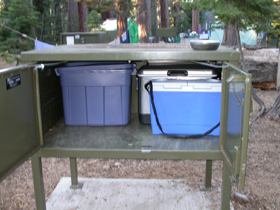
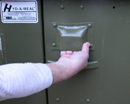
We recommend bringing a good tent that will not leak rather than sleeping in a bear box.
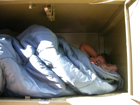

(These ladies just posed for this photo, they actually slept in a tent.)
Yellowstone National Park has also been installing bear boxes. This photo is from a 2025 report :
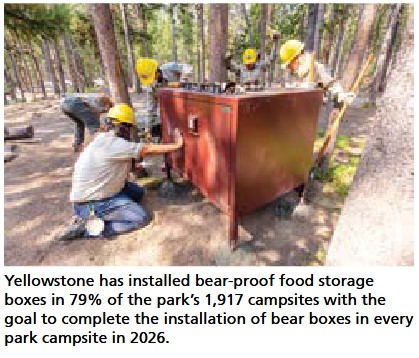
======================
from Yosemite Nature notes spring 2010:
“Sixty years ago, we hid butter and eggs in a
hole in the ground, covering them with a
wet burlap sack. We chilled watermelons in the
river. Canned goods could be left in a box or
bag under the table. If bears came visiting
during mealtimes, campers chased them away by
banging spoons on empty pots . . . still an
effective way to both confront the bears and alert
nearby campers to secure their food. When ice
chests became popular, we would hide them
in our cars under blankets. They were safe for
a few years, until bears learned to break into
cars and feast on whatever they found. Finally,
metal food storage boxes were provided. Now
the biggest challenge is to convince people to
put everything into the “bear boxes” and keep
the doors closed.”
======================
First-timer’s instructions has instructions for beginning snow campers for the De Anza College Outdoor Club winter trip, including info on the logistics of where to pitch your tent, dealing with iced car door locks, staying warm and comfy overnight while winter camping and more. Experienced people will probably pick up a few useful ideas.
Yosemite Valley free shuttle bus has hints for saving time using the free bus by better understanding the route, notes about the best bus stops (not always the obvious ones) for overnight accommodations,
AND best bus stops for and/or links to the following Yosemite Valley things to do:
art classes, bike rentals, bike paths, campsite availability, grocery store, hikes and their trailheads, horseback riding, ice skating, free and fee internet access, laundromat, lost and found, photo walk, rafting, Ranger talks/walks/evening programs, restaurants & cafeterias / pizzerias / grill / deli , places to get a shower, ski / snowboard / snow shoe walk, picnic, stargazing, swimming, waterfalls
and links to local Yosemite National Park weather reports.

The Yosemite National Park rangers would like you to call them
if you see a bear in Yosemite,
no matter where it is or what it is doing.
Since 2003 there has been a note in the Yosemite Guide: “REPORT ALL BEAR SIGHTINGS! To report bear sightings, improper food storage, trash problems, and other bear-related problems, leave a message for the Bear Management team at: 1 (209) 372-0322. Your call can be made anonymously.”
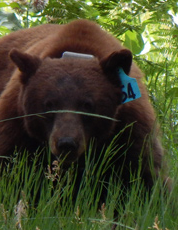
If you can, in all the excitement, try to notice if the bear has a tag (usually on the ear), the color of the tag and if possible, the number on it (the tag is large enough that with a telephoto lens you should be able to read the number).
From the Yosemite Daily Report newspaper:
“It is extremely important to remember to yell at bears that are in and around development, even if they are foraging on natural food. Though it is very tempting to get close for a picture, or just to watch these incredible animals, it is important not to give into this urge. Yelling at them if they are in residential areas or near people is critical to keep bears natural fear of humans. Giving bears plenty of space. When bears become too comfortable around people, they will often start causing damage to structures and vehicles, or will even become too bold around people, creating safety concerns.”
And the Yosemite Daily Report also said:
“Scare bears when you see them. . . in developed areas- Yell like you mean it!
Make as much noise as possible, try waving your arms, stomping your feet
or anything to make you look intimidating and to get the bear to run away.
We know it’s fun to see bears and it can feel mean to scare them,
but this is a simple way to truly help save a bear’s life.”



Where can I take a photo that looks like the one on a Yosemite postcard I just bought?
Places to take photos of Half Dome, Bridalveil Fall, El Capitan, Yosemite Falls and Staircase Falls.
Selfies can be great, OR dangerous. The use of cell phones for photography (with or without a selfie stick) has made preventable injury or even death by selfie common. They were only taking a selfie
Using a drone is illegal in Yosemite National park, including for photography. See an index to over a dozen park webpages with park laws, rules, regulations, policies and prohibitions about pets, bikes, permits, campground regulations, food storage, smoking, speed limits . . . and much more. Many of the park websites have detailed reasons behind the rules.
Hotel, cabin and tent cabin choices in Yosemite valley are at: Yosemite Valley accommodations
Restaurants, cafeterias, coffee bars, pizza, grocery stores are at: Yosemite valley restaurants, coffee bars, cafeterias, food service and groceries
– – – – – – – – – – – – – – – – – – – – – – – – – – – – – – – – – – –
Drivers in Yosemite should note that there have been sections of road in Yosemite Valley, part of the year, with two lanes (usually) in the same direction, with the right lane ONLY for the free shuttle buses, ambulances, ski bus, commercial vehicles with ten or more passengers. The NPS says: “The bus lane ensures emergency vehicles can respond to incidents when traffic is backed up and provides preference for mass transit.”
Parking and traffic jams in Yosemite valley tips and tricks has the above advice, with maps of each of the three major day-use parking lots, with advice to help you NOT get a Yosemite National Park traffic or parking ticket, and not contribute to preventable traffic backups. And some details of where you can’t park in Yosemite National Park, or can’t park without a permit.
——————————————————————-
The author of this webpage, (written as a reading assignment for my students), does not give any warranty, expressed or implied, nor assume any legal liability or responsibility for the accuracy, completeness, or usefulness of any information, product, or process included in this website or at websites linked to or from it. Users of information from this website assume all liability arising from such use.
